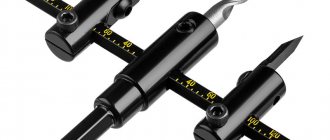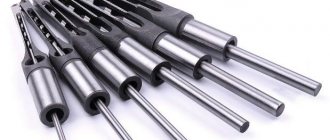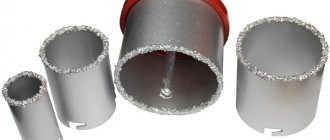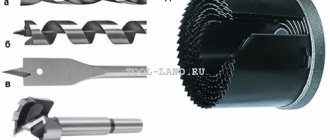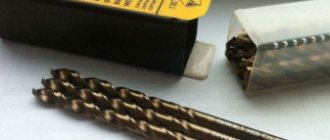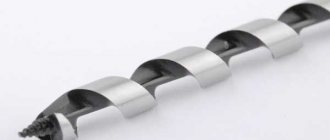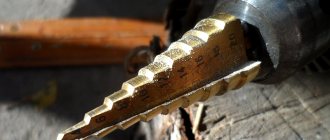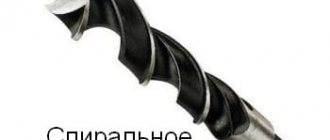How and with what to cut out curves and circles
Cutting round holes in plywood
Often, when repairing or installing various wooden products, it is necessary to drill a perfectly round hole.
In this article we will try to highlight all the ways in which such a hole can be cut. Options with the use of special tools, as well as without them, will be considered. How to cut plywood
A hacksaw with a very narrow blade, a jigsaw, a drill saw and a round file are among the hand tools that can be used to cut curves.
It is the narrow blade that provides maneuverability to the hacksaw, but for the same reason it is extremely difficult to operate. You must have a steady hand and an attentive eye to prevent deviations from the markings. However, do not try to work quickly. On the contrary, it is better to advance in small spurts. This will help you hold the saw handle more confidently and guide it exactly along the given line.
It is better to cut out small round or oval holes and “narrow” curves using special tools - a drill saw and a round file, which can also be used to clean out curves.
However, the most suitable tool for cutting rounded parts and holes is an electric hacksaw. Its advantage is not only that it saves energy and time. The included set of interchangeable blades with different teeth allows you to choose a blade for sawing almost any type of workpiece, be it wood, plywood or chipboard. In other words, an electric hacksaw can rightfully be called a universal tool.
How and with what to drill wood correctly?
Good afternoon friends!
Drilling
– a basic operation in the manufacture of any wooden product. Let's figure out what kind of drills a novice carpenter might need, what types of drills they are, and what advice drilling professionals give.
Let's start with what kind of drills are generally used in carpentry. It is easy to distinguish a wood drill from another drill - wood drills certainly have a guide pin in the center, which is installed at the point designated for the future hole. At the initial stage, it is enough to have two main types of drills in the workshop - spiral and flat:
1. Twist (screw) drill
- This is the most widely used type of drill. Such drills have a spirally twisted cutting edge and a central spike. For most simple products, a regular set of eight drills is sufficient (a standard set contains drills 3, 4, 5, 6, 7, 8, 9, 10mm). The price of such a set in a regular hardware store starts from 150 rubles. Of course, later you may need higher-quality drills that last longer without sharpening and drill more cleanly, but at the first stage, cheap ones will do just fine. Twist drills are great for blind holes because they leave a flat bottom. However, it is worth remembering that they do not remove chips well - deep holes are usually made with several dives of the drill.
2. Flat drill (feather or “feather”)
– as the name suggests, they have a flat shape and horizontal cutting edges. In addition to the guide tenon, they usually have scoring tenons or a tenon along the edges. They are usually used for through and non-through holes of large depths and diameters. It is also logical to immediately purchase a set of several drills, for example, 6 pieces (diameters 10, 12, 16, 18, 20 and 25 mm). The price of the set is around 200 rubles.
Round corners of furniture
You can even get injured by hitting a sharp corner of the table. Therefore, we recommend cutting corners where possible. For homemade furniture, they need to be rounded from the very beginning.
Cutting circles and curved lines is no more difficult than making an absolutely straight cut on a workpiece, but under one condition: you have the right tool in your hands and you are good at it.
Mark missing parts
It may happen that the holes that you drilled to insert a narrow blade with a hand or electric hacksaw will end up in useful areas. To avoid such mistakes, you should mark all missing parts of the workpiece with shading.
What is suitable for the template
You can make a circle on a workpiece not only with a compass. Any object of a similar shape is suitable for this purpose. This could be a pan, plate, cup or bowl. However, when starting work related to the repair of furniture or some piece of furniture, calculate in advance the need for parts with rounded contours or with round holes. It may be enough to make only minor changes to the design.
Instead of a compass
A school compass can also be useful in a home workshop, but its range of action is small. What if you need to draw a circle of large diameter?
An easy way is to do this with string, a nail and a pencil. The nail is carefully driven into the workpiece, the rope is secured to it at one end, and a pin is secured to the other end. The length of the rope determines the radius of the circle being drawn. The only condition is that the rope must be taut along the entire path of the pencil. Then the distance from the center (nail) to the circle in all sections of the marking will be the same.
Strip of cardboard or slats
An equally simple, but more reliable way is to use a strip of cardboard or, even better, a wooden plank instead of a rope. Drill two holes in this bar (strip) - one, smaller, for a nail, the other, larger, for a pencil. The distance between their tips should correspond to the radius of the desired circle. All that remains is to install the nail in the right place and rotate the bar around its axis.
Two sharpened nails and a wooden strip or a strip of thick cardboard can replace a compass.
How to draw ellipses
An ellipse is a rather complex shape, but to draw it on paper, you only need two thumbtacks, a piece of string and a sharpened pencil.
Attach two buttons to the surface of the workpiece at some distance from each other. Take a piece of rope, tie both ends into a knot and hook the rope onto the button heads. Now, with a pencil, draw a line that the stretched rope allows you to describe. You can change the shape of the ellipse at your discretion.
The distance between the two focal points of the ellipse is indicated by buttons. If you guide a pencil within the boundaries assigned to it by a rope, then the outline of an ellipse will appear on the paper.
The ellipse shape can be larger or smaller, thicker or narrower, depending on the distance between the buttons and the length of the rope.
Shot glasses, cups, plates, pots or baking dishes - in any household there are many round-shaped objects that can be used to mark a circle. If you are making something and decide to give your product a rounded shape, then first look to see if there is a suitable template among the household utensils. To be sure, select a few items and take them to the workshop. There you can immediately try them on the workpiece and determine what is most suitable. With some practice, you will be able to make rounded lines from several round objects with different radii. Arcs of a circle can be drawn sequentially, or bridges-transitions can be made between individual arcs.
Preliminary drawing
Before attempting to trace a curve on a piece of paper, design it on a large piece of paper or piece of corrugated cardboard. Only after the result is satisfactory in all respects can you cut out a template from paper and make markings on it on the workpiece.
You can draw circles and fragments of a circle using a cup or plate by simply tracing them with a pencil.
The working process
Then measure the thickness of the nail you used and drill a hole of the same diameter in the center of the circle. Use the hole left by the compass needle as a template.
Heat the pan high: simple life hacks for cooking perfect fish
Migration of dinosaurs 200 million years ago may have contributed to climate change
A hedge on the side of the road could help combat vehicle emissions in the future.
Now put the workpiece aside and take thin plywood. Make a large crosshair mark in the top left corner and drill through the center using a thin drill bit. Make sure your marks remain after you drill the hole.
Then make a second mark on the workpiece at a distance equal to the radius of your circle. Remember that the radius is half the diameter.
At the last mark, drill a hole with a drill of such a diameter that a jigsaw blade can fit into the resulting hole with a small gap.
Now let's move on to the part with the drawn circle. You need to drill the starting hole with a drill bit larger than the jigsaw blade. Try to drill so that the hole touches the line marked with the compass.
Happiness on the third try: what Maxim Leonidov’s young wife looks like
My sister-in-law and her husband never helped my mother-in-law. We did everything for them
We make comfortable, beautiful shelves from ordinary boxes: I share the result
It's time to put the blank and template together. Securely secure the workpiece to a sturdy surface. Insert a nail through both center holes in the blank and template, then line up the starting holes on the circle.
Now we need to attach the jigsaw to the turning template. For these purposes, I use a favorite secret: double-sided adhesive tape. It is easy to find at any hardware store. Apply tape to the turning template and insert the jigsaw blade into the starting hole. Once everything is installed correctly, press the structure against the adhesive tape for a few seconds.
Finally it was time to make the cut. Keep the jigsaw at full speed at all times, pushing forward with medium pressure. Don't worry about the tape coming off, trust me it won't.
Inserting a sink according to a template
The sink is one of the most important elements of kitchen equipment. If you decide to cut your sink into your kitchen worktop yourself, the first thing you need to do is prepare an exact template.
First, transfer the outer outline of the shell onto a thick sheet of paper. Next, measure the width of its sides, which will rest on the tabletop. Usually this is 2-3 cm. Now step back from the outline drawn on the paper, inward by the width of the side and draw a parallel line. This will be the cutting line.
When applying markings, make sure that the position of the template itself on the plate is correct. Of course, if all the corners of the sink are symmetrical, then nothing bad will happen if, according to the markings, it appears to be in a mirror image. But if the sink has the shape of a trapezoid and the roundings at the front corners differ from the roundings at the back, then under no circumstances confuse the front and back parts.
Electric hacksaw
If you need to cut a round-shaped part and saw a round hole in the workpiece, then an electric hacksaw is the most suitable tool. With its help, you will save effort and time, since such a saw has great advantages over a manual one. Thus, the blade of the electric hacksaw is narrower, which provides increased maneuverability. Further, it has replaceable blades with different teeth, which allows you to process workpieces of any type, that is, wood, plywood, chipboard (it is no coincidence that the tool is also called a jigsaw).
To cut a section inside the workpiece, a hole is first drilled for a hand saw. But if you have an electric hacksaw, then this is not necessary. The tool is brought to the workpiece with a slight tilt forward and turned on in this position. The saw will cut the hole itself. Just don’t put too much pressure on the body - this can lead to breakage of the saw blade.
Lead in a circle
This device, simple in design, makes cutting out round holes or arcs much easier. It is enough to mark the center of the circle on the workpiece, fasten the device along the mark and connect the rod coming from it with an electric hacksaw. The divisions on the rod help set the saw blade at the required distance from the center of the circle. As a result, without preliminary marking, you can cut a circle or saw an arc with a radius of 5 to 20 cm.
The device (more precisely, its “sole”) is attached to the surface of the workpiece with screws. They should be well tightened. If the fastening is not rigid and starts to wobble, then an even circle will not work.
Suitable for lefties too
Left-handers can also use the device, since the guide rod is attached to the movable unit both on the left and on the right. So cut at your own discretion - clockwise or counterclockwise.
Using such a device, you can cut a round hole with a diameter of 10 to 40 cm in the workpiece without preliminary marking.
When cutting holes or curves in small workpieces, sometimes you can’t do without a jigsaw. Replaceable blades with teeth of different shapes and locations allow you to work with wood of different densities. However, it should be taken into account that the depth of the cut is limited by the arc of the jigsaw, that is, the saw blade will not be able to move further than 30 cm from the edge of the workpiece.
Very thin, narrow saw blades can be easily damaged if the jigsaw is used incorrectly. The saw must be operated with careful, methodical movements. The main thing is to prevent the canvas from skewing. Otherwise, small and light workpieces will begin to move with the saw, which may ultimately lead to the blade bursting.
The thinnest jigsaw blade will “master” the narrowest curve, but only in small workpieces, since the advancement of the blade is limited by the arc of the jigsaw.
Drill saw
Neither a hand saw nor an electric hacksaw will help if you need to cut a small hole in the workpiece - less than 10 cm in diameter. A jigsaw may also be useless if the workpiece is large. In this case, the most suitable tool is a drill saw. With its tip it bites into the wood like a drill and thus makes a “starting” hole for further cutting. Externally, the saw is similar to a round file with the difference that its shaft is surrounded by a spiral around the cutting edge.
Drill saws are available with interchangeable attachments of various diameters, designed for processing both soft and hard wood, as well as a variety of materials made from it.
The working body of a drill saw is a metal rod with a cutting tip, like a gimlet, and a cutting edge that goes around the rod in a spiral.
This is what the narrowest of hand saws looks like. Thanks to the fastening unit, the blades in the hacksaw can be changed depending on the nature of the material being processed.
Drill attachment
One of the most popular and convenient options for cutting a hole is a special attachment for a drill. It is made in the form of a crown comb and has a rounded shape. With this attachment, cutting holes occurs quickly, and they turn out quite smooth.
drill bit for holes
Nozzles come in different diameters, which allows you to cut a hole of the required diameter. If you have already prepared a hole, we can advise you to try your hand at options trading.
You can also cut a large hole using a drill. To do this, it is necessary to pre-mark the outline of the hole to be drilled. Next, use a small drill to drill through holes along the contour prepared in advance. Next, using a jigsaw or a very sharp knife, we cut off the holes, thereby connecting the holes. After which you can smooth the circle using sandpaper of various grain sizes.
You can also cut the required hole using a chisel. It is enough to remove the wood layer by layer along the contour. This option is the least suitable for interior decoration. The hole must be smooth, which cannot be achieved by using improvised and unsuitable materials for the job. The best option would be to use a drill bit. The hole is even and has smooth edges.
Thus, to summarize, it becomes clear that you need to choose a tool for cutting a hole based on your goals. If you need a high-quality cut, then you cannot do without a special tool.
The task is to drill a large hole in the tree. The solution is wood crowns.
I welcome all visitors to my website, where I talk about various types of tools, give advice and recommendations on choosing and working with one or another tool. Today we will look at a tool with which you can easily drill a large-diameter hole in thin wood, most often plywood, fiberboard and chipboard.
The tool is a hole saw for wood, most often sold in sets with different saw diameters. This is very convenient - I bought one such set and you can drill holes of any large diameter, of course, if the saws that come in the set are of the diameter you need. Photo of this set:
For use at home, the Stayer set is quite suitable; it is optimal in terms of price and quality, moderately expensive, and comes with many saws of various diameters. It is worth noting that there are several variations of diameters, there are more complete sets with a large number of crowns, the diameters start from the smallest to the very large.
The most popular and best-selling set is 19-127 mm, this set contains 12 hole saws for wood of various diameters, it can be said to be universal, since it is almost always possible to select a crown for the desired diameter. However, its cost is 480 rubles. If you take sets with fewer attachments, then it will cost less.
So, let's look at the pros and cons of such a tool.
First the pros))
- Versatility - the ability to choose a crown for almost any diameter.
- Convenient suitcase, everything is stored in one place.
- Quick drilling of fiberboard, chipboard, plywood.
Minuses:
- The cut is not clean, unlike the holes drilled with a forstner drill.
- Sometimes it is not possible to choose the right diameter, for example, for some spotlights.
- Drilling depth is only 30 mm. Of course, you can drill deeper, but you will have to knock out the wood every time when the crown rests on the tree, because it is not deep.
All in all, a hole saw is a must-have tool for the home. For example, I recently pulled a 110 mm pipe through a thin partition (double layer of chipboard with a 50 mm block between them). How to drill 110mm holes in plywood?
Another note: Diamond cutting disc - we cut the stone with a bang.
There are several options - you can use a jigsaw, using a thin file for a figured cut. It is quite possible to drill a round hole, but you still won’t get a perfect circle.
But take a set of circular saws, choose the diameter of the bit closest to 110 mm, assemble it and drill a smooth, beautiful hole in a few minutes.
Criteria for choosing a quality option
Below we will look at the main types of devices for cutting holes in wood, but for now we will outline the criteria that any option must meet, regardless of its modification:
Advice! To be guaranteed to purchase a quality product, be it an electric jigsaw for wood or a circular saw, you need to contact official representatives of a particular brand or buy products from well-known stores that care about their reputation and do not sell cheap fakes.
Cheap core drill sets are so unreliable that they may only last for a single use
How to drill a log or thick beam? Of course with a screw drill
We continue to understand the equipment with which you can work on wood. In general, wood can be drilled with different drills; in the last article we analyzed the effectiveness of the Forstner drill, and figured out how and where it is recommended to use it.
There are a great many types of wood drills and it often happens that they are ideal for some jobs, but not suitable for others at all. Therefore, a home craftsman must understand what and how to drill into wood. Today's article will be about a screw drill, also called a twist drill.
It is for wood and will help out in cases where it is necessary to drill a deep hole. For example, you have a log house through which you need to stretch a water pipe or a bundle of cables. And only a twist drill can cope with thick wood. Of course, nothing prevents you from trying to use a regular perk, however, as I already said, drilling with it is inconvenient and it is not a guarantee that you will be able to complete the job.
Here is a photo:
As you can see, the tip is made in the form of a thin thread, which helps to screw in the drill perfectly at the initial stage of drilling. The ejection of chips occurs due to the screw edges (like any drill or brace), so drilling is easy. The shank is most often 6-sided, so the tool is securely mounted in the chuck of a drill or screwdriver.
It is necessary to work with such a drill at low speeds, so it is best to use a regular home drill with speed control or a powerful screwdriver with a high tightening torque.
But it is best, if possible, to use a low-speed drill with a speed of up to 800 (I recommend a rebir drill).
The most common use of such equipment is the fastening of logs. Workers who assemble log houses often come to our store and they buy “spirals” with a diameter of 25-28-30 mm and a length of 450-600 mm. As you know, in order to fasten the logs of a log house together, you need to drill them from above and insert iron reinforcement into the hole made. It is very important that the hole is drilled deeply, which is why a long drill is needed.
The standard range of lengths is as follows:
— 220 mm — 450 mm — 600 mm (the most popular).
To make holes with a diameter of 30 mm to a depth of 600 mm in wood, you need a very powerful power tool, so we recommend using a drill of at least 1000 Watt (and that is unlikely to be enough), as well as screwdrivers with a torque of at least 36 Nm. Of course, the most preferable option is a low-speed drill, which has a power of 1200 Watts; for such work you can’t imagine anything better. It is very powerful and easily pushes such a thick drill bit through solid wood.
The prices for such “consumables” are quite high, at least it is much more expensive than feather and Forstner drills. For example, 22*600 costs around 300 rubles. And the thickest ones come with a price tag of a piece of rubles. They are taken only when it is necessary to drill a hole in a log house for a sewer pipe, etc.
However, if you consider that the drill is powerful and heavy, and it is used to perform specific work, then you should not worry about the price. Because anyway, nothing else can drill through 3 logs at once.
Another note: GOI pasta - everything you didn’t know
Types of products and their features
Let's look at what options you can find in our retail network and how they differ from each other.
Feather drills
The most common and budget option, which is quite convenient for even inexperienced craftsmen to work with. And you can also master this simple process with your own hands.
Let's look at the main advantages of this solution:
- The diameter range varies from 10 to 60 mm.
- The work is done quite quickly, but the quality of the hole is low, and it is unlikely to achieve an ideal result.
- The maximum drilling depth is approximately 150 mm.
- Products are sold either in sets of 5-6 pieces or individually, so you decide which option is right for you.
- If necessary, you can buy an extension that clamps the drill and increases its length by 300 mm.
Drilling wood and chipboard
In general, drilling wood can be done even with an ordinary nail or a piece of wire with a flattened end. Special drills for wood have to be resorted to only when it is necessary to drill a hole of large diameter, or when increased demands are placed on surface cleanliness and accuracy. There are several types of such drills:
- spiral (a);
- twisted or single-spiral (it is sometimes also called spiral) (b);
- feather (in);
- annular (crown) (d);
- Forstner cylindrical drill (d).
Wood drills are made from alloy tool and carbon tool steels; metal cannot be processed with them.
Use a twist drill to drill holes of small to medium diameter. It can easily be replaced with a metal drill bit, although the hole will be cleaner if you use a wood twist drill bit.
The single twist drill has a sharp cutting edge and an auger shape that removes chips well. It is used when you need to get an accurate deep hole with a clean surface of the walls.
A feather drill is usually used when drilling holes with a diameter of 10 to 25 mm, although there are drills with a diameter smaller than 10 and larger than 25 mm. This drill is the simplest in design and the cheapest, so it is reasonable to use it in all cases where high demands are not placed on the quality of the hole. The disadvantages of a feather drill include poor direction, low diameter accuracy, rough surface of the hole walls, and the need to periodically remove chips by stopping drilling and removing the drill from the hole. To the merits. simplicity and cheapness.
Crowns are used when drilling large diameter holes. up to 100 mm or more. The kits contain one mandrel with a shank and a centering drill and several bits that are inserted into the mandrel.
The Forstner drill has a centering point and a sharp scoring tip. Thanks to the latter, it is distinguished by precise cutting geometry. Typically used for drilling blind holes to precise dimensions in softwood, chipboard or laminate for the installation of furniture canopies.
Forstner drill bits can be short or long pointed.
It is more difficult to make a blind hole for a hinge in a thin door with a Forstner drill with a long point, since the point can make a through hole . But a drill with a short tip is more prone to moving to the side. In addition to differences in the length of the tip, the Forstner drills shown in the photo above differ in their maximum rotation speed. So a drill with a short tip has welded knives made of high-speed steel and is suitable for working at high speeds, and a drill with a long tip has a maximum rotation speed when working with soft wood equal to 1000 rpm.
There is another device for cutting large holes. This is a ballerina designed for cutting large (up to 300 mm) holes in thin pieces of wood, chipboard, fiberboard and other materials.
The ballerina consists of a centering drill and two cutters that are used to cut out a circle. The displacement of the cutters along the guide sets the diameter of the circle being cut. To rotate the ballerina, use a brace or drill with a low speed. You can also rotate it manually.
How to drill wood and chipboard
To make the drill perpendicular, jigs are used. The latter are especially convenient for making holes in cylindrical parts.
Drilling chipboard requires special attention. due to its fragile structure. The presence of laminated or veneer coating complicates the task. To avoid their peeling, use drills with a sharp edge (in particular, a cylindrical Forstner drill) and a backing plate at the exit. To mark holes, be sure to use an awl.
Sources:
https://delajsam16.ru/bolshoe-otverstie-v-metalle/ https://bezhelme.ru/osnastka/koltsevaya-pila-po-derevu-dlya-sverleniya-bolshih-otverstiy/ https://thestroika.com/ drel/kak-sdelat-otverstie-v-dereve-bez-dreli.html https://booktube.ru/sverlenie-bolshih-otverstij-v-dereve/ https://tool-land.ru/sverlenie-dereva.php
What is a wood ballerina
A circular adjustable ballerina drill is a device that is designed for drilling round holes of large diameter. The tool has a simple design. It consists of a shank with a transverse rod on which movable carriages with cutters are attached. The rod has markings according to which you can set the required spread of the cutters relative to the center of the intended hole. A core drill is fixed in the middle of the shank. It serves as a centering element and support when drilling.
In addition to designs with two cutting elements located symmetrically, there are ballerinas with one cutter or even three. In the latter case, they are located on the base in the form of a disk with grooves.
Ballerina on wood. We can handle any diameter!
Any person who works with wood or wood-based materials quite often needs to drill a round hole of large diameter in a sheet plate. Of course, you can use a jigsaw and cut out the required circle with it, but this is not always convenient. In such situations, a wood ballerina is used, which is a special device for producing precisely round holes of large diameters.
Tool functionality
A high-quality ballerina is made of high-strength steel, which makes it possible to use the device in working with soft and hard wood.
This tool has an adjustable drilling diameter. This allows you to make holes of almost any diameter. The limitation of the drilling range depends on the size of the ballerina. Manufacturers produce devices with the following cutter spread limits:
- from 30 to 120 mm;
- from 40 to 200 mm;
- from 40 to 300 mm;
- from 40 to 400 mm.
The maximum drilling diameter is limited by the rod on which the cutters are mounted. The minimum is the thickness of the shank.
A ballerina drill can be used in any places where using a jigsaw or a hand router would be inconvenient. For example, this may be assembled and installed furniture, in the part of which it is necessary to drill a neat hole, given the limited space. Another example is an uneven (concave or curved) surface. It’s unlikely that you’ll be able to do everything smoothly and neatly with a jigsaw or milling cutter. It will be difficult to control the inclination of the tool relative to the surface. A ballerina can easily cope with this task.
Features of working with the tool
The principle of working with a circular drill is simple. A hole is drilled using a centering drill, and then the cutters are put to work. They gradually make a narrow groove, gradually cutting through the material in a circle to the full depth.
The materials used in working with the ballerina are varied: wood, fiberboard, chipboard, MDF, plasterboard, plastic. One common point is that the thickness of the part should be no more than 15-20 millimeters. This parameter is limited by the length of the incisors. Usually the manufacturer indicates the maximum drilling depth on the packaging. If you try to drill into thicker material, you may experience problems with ragged edges.
The use of a tool with one cutter is characterized by runout. This is caused by a lack of balancing relative to the longitudinal axis of the drill. The beating will be especially noticeable when cutting large diameter holes. Cut holes using a drill at low or medium speed. When working on a drilling machine, such problems do not arise.
How to choose and what to pay attention to
Choosing a high-quality circular drill is quite easy. The main thing is to know the main points that you should pay attention to first, but also not to lose sight of the little things.
The design is a very important point: a wood ballerina comes with one chisel or two or more. For frequent use, it is better to purchase an option with two or three cutting elements. It is easier to work with such devices and the quality of the processing performed will be at an acceptable level.
It would not be superfluous to be able to replace individual parts. Inexpensive circle drills can have a solid shank with a permanent center drill and rod.
Metal, its quality determines its strength and ability to withstand workloads. High-quality tools are made from high-strength steel or alloys. The shank and cutter holders are shaped using a machine tool. The rod is usually stamped and made of the same metal.
Cheap options often use soft metal or alloys, which can be brittle. Under load, parts may become deformed or break. Such a tool will not last long and it will also be difficult to achieve accuracy from it.
The quality of workmanship, the main feature is the absence of backlashes and distortions. All parts must fit together and be securely fastened with fixing screws.
The markings of a high-quality ballerina's barbell are stamped. Sometimes the divisions are highlighted with bright paint for better visibility.
Cutters and high-quality cutting elements are made from hardened tool steel. They are secured to the holders with rivets or soldering. Solid cutters with holders (made of the same metal) quickly become dull and are not durable.
Manufacturer, when choosing any tool and consumables, preference should be given to well-known and long-proven brands and brands. The most common are Topfix, Stayer, Irwin, Strum.
Purchasing an adjustable circular drill for use at home, or if you need to drill several holes, is completely worth it. This eliminates the need to purchase an expensive tool that may only be needed a few times.
Advantages and selection criteria
The advantages of a ballerina are as follows:
- obtaining neat holes with a diameter of up to 300 mm;
- simple and reliable design;
- low price, which, if it is necessary to make only a few holes (in everyday life, for example), turns out to be decisive;
- Possibility of adjusting the diameter.
Many people argue that where woodworking is used, crowns or circular saws could be used. However, the crowns have a fixed diameter without the possibility of adjustment and a rather high price. Therefore, they are more often used in such work where it is necessary to cut a large number of identical holes (for fastening standard lamps, sockets, etc.). If you need to work with several holes of different diameters, a ballerina is more suitable.
This device should be selected carefully, using criteria that are important for any instrument. This is the quality of workmanship, the accuracy of sharpening knives, the reliability of fixing structural elements and other subtleties known to anyone who has at least occasionally encountered cutting equipment. Despite this, many choose a ballerina based only on such criteria as cost. These people should be even more careful, since a cheap tool may not have the proper characteristics and can be quite dangerous. You should always remember that rotation occurs at high speed and an insecurely fixed cutter can hit a person or simply fly to the side with an unpredictable result.
However, for everyday use, with small volumes of work or the need to drill several holes of different diameters, the ballerina for wood shows its good side and, thanks to its low cost, pays for itself quite quickly. It is not always justified to use other types of tools for such tasks.
DRILLING WOOD, CHIPBOARD AND PLYWOOD: HOW TO DRILL WOOD?
It's time to talk about drilling wood, chipboard or plywood. At first glance, it seems that what could be simpler than drilling wood? Wood can be successfully drilled using ordinary metal drills, or instead of a drill, you can use a regular nail or wire with a flattened end. But if every millimeter is important for the desired hole in wood and special surface cleanliness is necessary, then it is necessary to use special drills for drilling wood. Let's take a closer look at the types of drills for wood.
DRILLS FOR WOOD, CHIPBOARD AND PLYWOOD
Special drills for wood are divided into several main types: spiral, twisted (single-spiral), feather, annular (crown), cylindrical (Forstner drill). All these drills are intended exclusively for wood: neither stone nor metal can be processed with them.
Twist drill
This drill bit is designed for drilling small to medium diameter holes. It is this drill that can be tensioned and replaced with a drill for metal, but neither accuracy nor good cleanliness of the hole will be ensured in this case.
Twisted (single-spiral) drill
This drill is used when you need to make a deep, very precise hole with a clean surface on the walls. This drill is equipped with a sharp cutting edge and has an auger shape, which facilitates good chip removal.
Feather drill
This drill is used to drill holes with a diameter of 10 to 25 mm, although variations are possible. The main advantage of such a drill is its low cost. The main disadvantages are poor guidance, low accuracy, poor surface finish of the hole walls, chip stagnation and the need to frequently stop drilling to clean the hole.
Annular drill (crown)
Crowns are used for drilling large holes (diameter 100 mm or more). The set includes one mandrel with a shank (for clamping in a drill) and a centering drill, as well as several hole saws (crowns) that are installed directly into the mandrel.
Forstner drill
This drill features precise drilling geometry, it is equipped with a centering tip and a sharp scorer. A Forstner drill bit is used for drilling blind, precise holes in chipboard, laminate or soft wood. It is worth noting that the centering tip of the Forstner drill can be long or short. A drill with a short point is more prone to moving to the side at the beginning of drilling, but it is also irreplaceable if you need to make a blind hole in a thin panel.
Ballerina for tree
Of particular note is a device for drilling large-diameter holes (up to 300 mm) in thin wooden panels, such as ballerina (chipboard, fiberboard, etc.). A ballerina is made from a centering drill and two cutters located on graduated guides. By shifting the cutters along these guides to the required distance, you can set the required hole diameter. You need to drill with a ballerina at very low speeds or using a hand drill.
Types of wood drills
Depending on the design features, types of wood drills are divided into several categories. The classification is as follows:
- spiral;
- screw;
- feathers;
- Forstner drills;
- crowns;
- milling;
- cork;
- combined;
- countersink.
They are selected depending on the thickness of the material being processed, the diameter and depth of the hole, and the type of shank in the tool.
How to drill a large hole in wood or metal
Attention is drawn to the color of the drill, which changes with different heat treatment technologies:
- Black. In order to increase strength, steam treatment was used.
- Yellow-gold. Treatment was carried out in order to remove surface stresses from the metal.
- Bright gold. Using heat treatment, the surface layer was saturated with titanium nitride.
- Grey. The surface was not sprayed.
Feather devices
The feather one has a central part made in the shape of a feather. 2 incisors diverge in both directions. On the other side there is a hexagonal tip. The operating rules are as follows:
- Before starting work, use a core to mark the drilling location.
- The equipment used is an electric drill. The number of revolutions is set depending on the diameter of the drill. The larger it is, the lower the revolutions.
- When drilling a deep hole, an extension is used, which is attached to the drill with a lock.
- At the first stage, the contour of the hole is outlined. To do this, the feather part is positioned perpendicular to the surface and pressure is applied with little force.
- Chips are not removed from the groove on their own, so work must be stopped from time to time to remove them.
The tool is the easiest to maintain. Its sharpening is carried out according to the sample. The main thing is to sharpen the central part exactly in the axis. A slight displacement will cause the drill to move to the side.
READ The Hammer Hit But Doesn't Twist
Milling drills
Using milling drills, you can not only drill holes, but also make grooves. Therefore, they are used in complex machining of parts. The design of the drill consists of a shank and a working part, which is immediately sharpened for the required operation.
The tail section comes in different configurations:
- Triangular. Suitable for three jaw chuck. The shank does not rotate even with high torques.
- Hexagonal. Installation is carried out both in a three-jaw chuck and in a standard one. There is a risk of twisting.
- Conical. For use in production only.
- Tetrahedral. They are rarely used, although there is no turning effect in the cartridge.
